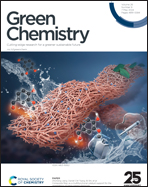Comparative environmental assessment of zeolites synthesized from chemicals and natural minerals†
Abstract
Synthesizing zeolites, which are important materials used in the petroleum and chemical industries, from natural aluminosilicate minerals has been qualitatively recognized as a greener approach compared to that from traditional Si- and Al-containing chemicals; however, studies on the quantitative environmental impacts are still lacking. Herein, life cycle assessment (LCA) and green metrics (atom economy and environmental factor) were employed to comparatively assess the life cycle environmental impacts of zeolites synthesized from chemicals and natural minerals at the industrial scale. The values of seven LCA impact categories and sensitivity analysis between them were thoroughly compared. The results showed that, for each category, the synthesis from natural minerals has lower environmental impacts to varying degrees than that from chemicals. Further efficiency analysis of zeolite manufacturing technologies by green metrics indicated that the synthesis from natural minerals outperforms that from chemicals in terms of the resource utilization rate. The quantitative results indicate that significant benefits stem from the replacement of raw materials from chemicals to natural minerals. This work may provide a basis for the future selection and upgrade of zeolite production processes.



 Please wait while we load your content...
Please wait while we load your content...